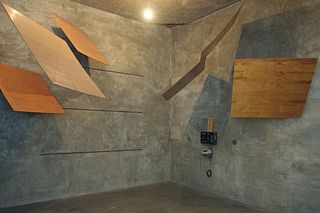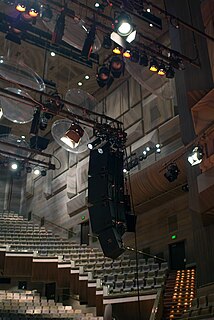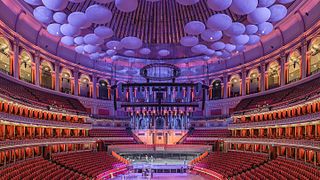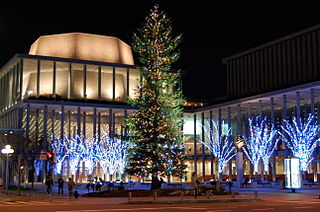
Acoustics is a branch of physics that deals with the study of mechanical waves in gases, liquids, and solids including topics such as vibration, sound, ultrasound and infrasound. A scientist who works in the field of acoustics is an acoustician while someone working in the field of acoustics technology may be called an acoustical engineer. The application of acoustics is present in almost all aspects of modern society with the most obvious being the audio and noise control industries.
Reverberation, in acoustics, is a persistence of sound, or echo after a sound is produced. Reverberation is created when a sound or signal is reflected causing numerous reflections to build up and then decay as the sound is absorbed by the surfaces of objects in the space – which could include furniture, people, and air. This is most noticeable when the sound source stops but the reflections continue, their amplitude decreasing, until zero is reached.
Room acoustics describes how sound behaves in an enclosed space. Sound of different frequencies behaves differently in a room. Reflections between walls, floor and ceiling create room modes at specific frequencies and locations. Reflections also produce reverberation.

An echo chamber is a hollow enclosure used to produce reverberation, usually for recording purposes. For example, the producers of a television or radio program might wish to produce the aural illusion that a conversation is taking place in a large room or a cave; these effects can be accomplished by playing the recording of the conversation inside an echo chamber, with an accompanying microphone to catch the reverberation. Nowadays effects units are more widely used to create such effects, but echo chambers are still used today, such as the famous echo chambers at Capitol Studios.

Acoustical engineering is the branch of engineering dealing with sound and vibration. It includes the application of acoustics, the science of sound and vibration, in technology. Acoustical engineers are typically concerned with the design, analysis and control of sound.

Symphony Hall is a 2,262 seat concert venue in Birmingham, England. It was officially opened by the Queen on 12 June 1991, although it had been in use since 15 April 1991. It is home to the City of Birmingham Symphony Orchestra and hosts around 270 events a year. It was completed at a cost of £30 million. The hall's interior is modelled on the Musikverein in Vienna and the Concertgebouw in Amsterdam. The venue, managed alongside Town Hall, presents a programme of jazz, world, folk, rock, pop and classical concerts, organ recitals, spoken word, dance, comedy, educational and community performances, and is also used for conferences and business events as part of the International Convention Centre.

The Royal Festival Hall is a 2,700-seat concert, dance and talks venue within Southbank Centre in London. It is situated on the South Bank of the River Thames, not far from Hungerford Bridge, in the London Borough of Lambeth. It is a Grade I listed building, the first post-war building to become so protected. The London Philharmonic Orchestra, the Philharmonia Orchestra and the Orchestra of the Age of Enlightenment are resident in the hall.

Louise M. Davies Symphony Hall is the concert hall component of the San Francisco War Memorial and Performing Arts Center in San Francisco, California. The 2,743-seat hall was completed in 1980 at a cost of US$28 million to give the San Francisco Symphony a permanent home.

Architectural acoustics is the science and engineering of achieving a good sound within a building and is a branch of acoustical engineering. The first application of modern scientific methods to architectural acoustics was carried out by the American physicist Wallace Sabine in the Fogg Museum lecture room. He applied his newfound knowledge to the design of Symphony Hall, Boston.

Wallace Clement Sabine was an American physicist who founded the field of architectural acoustics. Sabine was the architectural acoustician of Boston's Symphony Hall, widely considered one of the two or three best concert halls in the world for its acoustics.
A reverberation chamber or room is a room designed to create a diffuse or random incidence sound field. Reverberation chambers tend to be large rooms and have very hard exposed surfaces. The change of impedance these surfaces present to incident sound is so large that virtually all of the acoustic energy that hits a surface is reflected back into the room. Arranging the room surfaces to be non-parallel helps inhibit the formation of standing waves - additional acoustic diffusers are often used to create more reflecting surfaces and further encourage even distribution of any particular sound field.
Acoustic absorption refers to the process by which a material, structure, or object takes in sound energy when sound waves are encountered, as opposed to reflecting the energy. Part of the absorbed energy is transformed into heat and part is transmitted through the absorbing body. The energy transformed into heat is said to have been 'lost'.

Acoustic foam is an open celled foam used for acoustic treatment. It attenuates airbone sound waves, reducing their amplitude, for the purposes of noise reduction or noise control. The energy is dissipated as heat. Acoustic foam can be made in several different colors, sizes and thickness.

The Hexagon is a multi-purpose theatre and arts venue in Reading, Berkshire, England. Built in 1977 in the shape of an elongated hexagon, the theatre is operated by Reading Borough Council under the name "Reading Arts and Venues" along with South Street Arts Centre and Reading's concert hall.

Diffusion, in architectural acoustics, is the spreading of sound energy evenly in a given environment. A perfectly diffusive sound space is one in which the reverberation time is the same at any listening position. Most interior spaces are non-diffusive; the reverberation time is considerably different around the room. At low frequencies, they suffer from prominent resonances called room modes.
LARES is an electronic sound enhancement system that uses microprocessors to control multiple loudspeakers and microphones placed around a performance space for the purpose of providing active acoustic treatment. LARES was invented in Massachusetts in 1988, by Dr David Griesinger and Steve Barbar who were working at Lexicon, Inc. LARES was given its own company division in 1990, and LARES Associates was formed in 1995 as a separate corporation. Since then, hundreds of LARES systems have been used in concert halls, opera houses performance venues, and houses of worship from outdoor music festivals to permanent indoor symphony halls.

The Hyogo Performing Arts Center (HPAC) is a performing arts center in the city of Nishinomiya, Hyōgo Prefecture, Japan, next to Nishinomiya-Kitaguchi Station operated by Hankyu Corporation. The Center was opened in 2005 to mark the ten-year anniversary of the Great Hanshin earthquake which largely devastated Nishinomiya and the surrounding cities.
The Variable Room Acoustics System is an acoustic enhancement system for controlling room acoustics electronically. Such systems are increasingly being used to provide variable acoustics for multipurpose venues.
Diffuse field acoustic testing is the testing of the mechanical resistance of a spacecraft to the acoustic pressures during launch.
Apparent source width (ASW) is the audible impression of a spatially extended sound source. This psychoacoustic impression results from sound radiation characteristics and properties of an acoustic space. Wide sources are desired by listeners of music because these are associated with sound of acoustic music, opera, classical music, historically informed performance. Research concerning ASW comes from the field of room acoustics, architectural acoustics and auralization as well as musical acoustics, psychoacoustics and systematic musicology.















